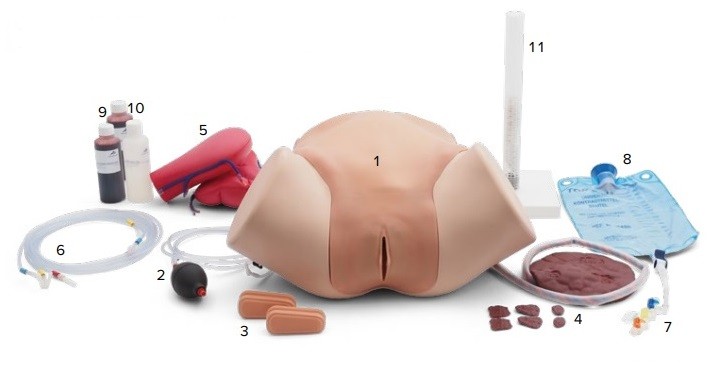- Your cart is empty
- Continue shopping
Shop
Postpartum P97 Pro Haemorrhage Training Simulator
Postpartum P97 Pro Haemorrhage Training Simulator
Postpartum haemorrhage is an emergency where heavy bleeding induced by tearing occurs after childbirth delivery. The Postpartum P97 Pro Haemorrhage Training Simulator gives nurses and doctors the opportunity to improve the standard of care given to the large number of women who experience postpartum haemorrhaging every year.
What’s Included?

- 1 x PPH P97 Torso Mannequin (Label 1)
- 1 x Deflation Bulb with Tube (Label 2)
- 1 x Vaginal Rupture Insert (Label 3)
- 1 x Set of Replacement Residuals (Label 4)
- 1 x Model Placenta (Label 4)
- 3 x Residual Placenta Pieces (Label 4)
- 2 x Foam Uteri (Label 5)
- 1 x Bleeding Connector (Label 7)
- 1 x Blood Reservoir Bag (Label 8)
- 2 x 250ml Containers of Artificial Blood Concentrate (Label 9)
- 1 x 250ml Container of Lubricant (Label 10)
- 1 x Drying Stand (Label 11)
What Is Postpartum Bleeding?
Postpartum bleeding is any heavy episode bleeding that occurs after giving birth. It is most likely to occur during the first 24 hours after giving birth and affects up to 5% of women during or after childbirth.
What Are the Leading Causes of Childbirth Haemorrhaging?
The P97 Pro Simulator focuses on providing realistic training relating to the three leading causes of postpartum bleeding. They are:
- Uterine Atony (Tonus)
- Laceration and rupture (Trauma)
- Retained tissue from the placenta (Tissue)
What Postpartum Emergency Situations Does the P97 PRO Simulate?
The P97 PRO is ideal for training the following techniques and emergency management procedures:
- Diagnosis of uterine atony by abdominal examination
- Practice of fundal massage and bimanual compression
- Suturing vaginal tears
- 360° cervical visual inspection
- Manual removal of a retained placenta
- Packing the uterus with gauze
- Presentation of severe obstetric haemorrhage
- Blood loss estimation
- Fluid-less bladder catheterisation
- Uterine compression suture techniques
Why Is Training Postpartum Situations Vital?
Every year 14 million women worldwide experience some degree of postpartum haemorrhage (PPH). If PPH is not diagnosed quickly after delivery, the severe bleeding that accompanies the condition can be fatal.
If training simulators and the knowledge they provide are not of the highest standard, the level of care given during an emergency which requires instant action will suffer. Models that simulate a range of different outcomes and eventualities are of the utmost importance in the medical world.
Key Features of the P97 PRO Haemorrhage Simulator
The P97 Haemorrhaging Simulator provides an unrivalled level of lifelike training designed to prepare professionals for diagnosis and condition management during childbirth. Please view the features and benefits of the P97 PRO below:
- Lifelike texture of the body mirrored accurately throughout the simulation model
- Facilitates the user dealing with multiple simultaneous at one time
- Capable of simulating both an atonic and contracted uterus along with varying degrees of uterine tone
- Facilitates the practice of both fundal massage and bimanual compression
- Replaceable rupture inserts allow for the suturing of vaginal tearing
- Realistic post-delivery cervix state
- Allows for training regarding the manual removal of a retained placenta
- Supplied with a range of tools and replacement pieces for ease of training
- Volume scale on the blood reservoir allows you to calculate approximate blood loss during training
Set Up Instructions
Please follow the instructions below to correctly set up a P70 PRO Simulation Device:
- Add artificial blood to the reservoir bag provided. The blood concentrate provided should be diluted by mixing 250ml with 1.5l of water
- Connect the colour coded bleeding connector to the reservoir bag
- Connect the blood delivery tubes to the corresponding colour codes on the connector
- Unbutton the silicon piece and remove the abdominal foam backing
- Connect the ends of each blood delivery tube to the colour coded openings at the bottom of the uterus
- Attach the deflation bulb to the bottom of the uterus
- Reinsert the abdominal foam backing and button the simulator shut
- Finally, fix the vaginal rupture insert to the correct spot inside the vagina, ensuring the blood delivery tube is firmly inserted
Safety Instructions
- Do not wear jewellery whilst operating the simulator
- Follow the assembly instructions detailed above
- Wear gloves at all times when using this product
- Keep away from heating sources
- Do not use any attachments other than those supplied in the package
- Follow the cleaning instructions detailed below
Washing Instructions
Each individual part of the P97 Haemorrhage Simulator can be washed.
Dimensions and Specification Information
- Pelvic Unit Weight: 7.5kg
- Dimensions (LxWxD): 44 x 52 x 24cm
Please contact the Medical Supplies Customer Care Team by telephone on +44 7985 753735 for enquiries pertaining to the Delivery of this product.




![P97P_04_1200_1200_Postpartum-Hemorrhage-Simulator-PPH-Trainer-P97-PRO-04[1]](https://media.medicalsuppliesgh.com/2022/05/P97P_04_1200_1200_Postpartum-Hemorrhage-Simulator-PPH-Trainer-P97-PRO-041.jpg)
![P97P_04_1200_1200_Postpartum-Hemorrhage-Simulator-PPH-Trainer-P97-PRO-04[2]](https://media.medicalsuppliesgh.com/2022/05/P97P_04_1200_1200_Postpartum-Hemorrhage-Simulator-PPH-Trainer-P97-PRO-042.jpg)
![P97P_04_1200_1200_Postpartum-Hemorrhage-Simulator-PPH-Trainer-P97-PRO-04[4]](https://media.medicalsuppliesgh.com/2022/05/P97P_04_1200_1200_Postpartum-Hemorrhage-Simulator-PPH-Trainer-P97-PRO-044.jpg)
![P97P_04_1200_1200_Postpartum-Hemorrhage-Simulator-PPH-Trainer-P97-PRO-04[3]](https://media.medicalsuppliesgh.com/2022/05/P97P_04_1200_1200_Postpartum-Hemorrhage-Simulator-PPH-Trainer-P97-PRO-043.jpg)










Customer reviews
Reviews
There are no reviews yet.
Write a customer review